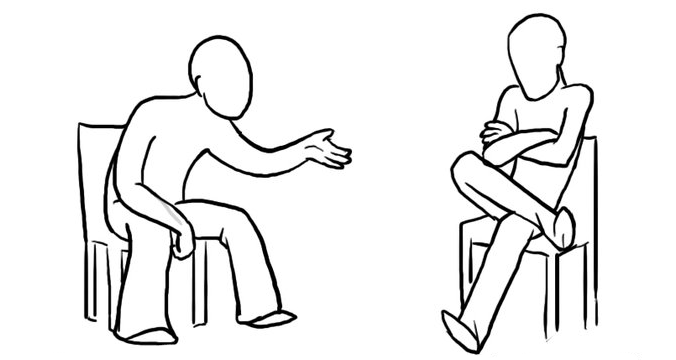The Body: A Vital Part of Language
Medical Pharmaceutical Translations • Jan 20, 2017 12:00:00 AM

As linguists, we often talk about languages – how to learn them, tricks to retain them and the culture that is connected to them – all in an effort to become fluent. Yet, the interconnected web of language and communication is never complete without body language. That’s right, the effective use of body language plays a key role in communication. And interpretations vary from country to country, culture to culture, making it vital to language learning as a whole. In fact, some researchers conclude that “nonverbal communication accounts for the majority of information transmitted during interpersonal interactions.”
People are constantly giving off silent messages through body movements, facial expressions, voice tone and loudness. Whether it’s a tiny hand gesture or a certain posture, subtle involuntary movements register immediately and can have long-lasting repercussions.
There is some controversy surrounding the theory that body language is universal, however, most people can agree that there are some body language tips to keep in mind when dealing with people in every-day life America.
Assume a pose Need to feel confident when you are feeling timid? Time to strike a pose. Harvard Business School professor and Social Psychologist, Amy Cuddy found that simply holding your body in expansive, “high-power” poses, such as leaning back with your feet on the desk and hands behind your head, or with your hands on your hips, or with legs and arms wide open for two minutes, stimulates hormones. Power poses specifically increase testosterone, which is linked to power and dominance and reduce cortisol, the stress hormone. You come across as more confident and —according to the study— people are more influenced by how they feel about you than by what you’re saying.
Smile A smile directly influences how others respond to you. They make us feel better about ourselves and make us look more approachable. When we see someone smile, we think they are more cooperative and trustworthy. Best of all, smiles that beget smiles make everyone’s emotional state better —something we all need.
Speak softly A relaxed voice conjures up images of a relaxed, confident person. If your pitch rises at the end of sentences, it sounds as if you are asking a question or are unsure of what you are saying. One way to sound more authoritative is to start at one level, gently rise in pitch throughout the sentence and drop back down at the end. Onscreen reporters are good at this type of speech.
Remove barriers to collaboration Remove anything that separates you from the rest of the team. This can even be as simple as a coffee cup and where you hold it. Is it in front of your body? Is it closer to your face – a clear indicator that you are feeling insecure? Or is it down near waist level, a sign that you are more comfortable?
Get Handy Our brain’s Broca’s area, which is important for speech production, is directly affected when we use our hands when speaking. Gesturing goes hand-in-hand with speech and can actually help us form clearer thoughts and greatly improve our verbal content.
Touch to create a bond A powerful nonverbal cue includes touching someone on the arm, hand or shoulder. Even if it is only for 1/40 th of a second, it creates a strong bond. Most of us are familiar with the traditional handshake, this tactile gesture that makes a lasting and positive impression. One study showed that people are two times more likely to remember you if you shake hands with them. The same study also found that people react to those with whom they shake hands by being more open and friendly.
Listen for participation To increase participation, focus on those who are speaking. Avoid the urge to check your text messages, email, or look at other people. If your head and torso face the person speaking, you show you are paying attention. Other nonverbal clues to show you are engaged include leaning forward, nodding, and tilting your head. It is equally as important to make sure people know you are listening as it is to hear them.
Be a mirror When we involuntarily imitate another’s body language, we are saying we like or agree with them. When we want to build rapport with someone, we can try intentionally mirroring someone’s facial and body gestures. When done subtly, we help make the other person feel understood and accepted.
The truth lies in the sole Studies show we can judge a person’s body language best when we can see their entire body. Why? When people who are anxious or emotional try to control their body language, they often forget to control their feet. When stressed, people tend to increase their foot movements; they shuffle or fidget or kick. We have instinctively been reacting to foot gestures all our lives.
Be open to remembering In their book The Definitive Book of Body Language: The Hidden Meaning Behind People’s Gestures and Expressions, Allan and Barbara Pease found that those who listen to lectures while seated with arms and legs unfolded, remembered more than their counterparts who sat in more defensive postures with folded arms and legs. They essentially were less “closed off” to remembering what they were hearing. If you come across people who are not open to you, they will not be open to your suggestions and will not be persuaded. If you yourself look folded, you will not be perceptive to new ideas or thoughts either. Whether you are speaking or listening, these body-language tips are bound to be helpful. Keeping them in mid will help increase your non-verbal impact and improve your communication skills.
Ilona Knudson
